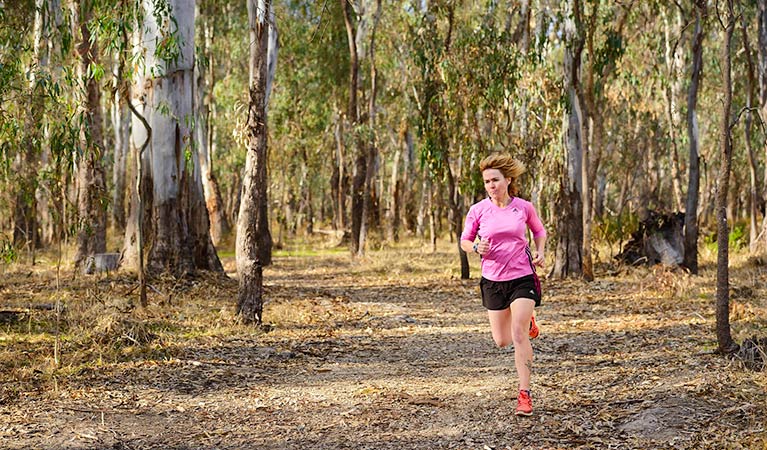Gulpa Creek Forest walks
Murray Valley Regional Park
Overview
Gulpa Creek Forest walks, in Murray Valley Regional Park, is an easy path to walk along with your dog and great for birdwatching with opportunities to go canoeing or kayaking, not far from Mathoura.
- Accessibility
- Hard
- Distance
- 5km return
- Time suggested
- 1hr - 1hr 30min
- Grade
- Grade 2
- What to
bring - Drinking water, hat, sunscreen
- Please note
Gulpa Creek is a great destination for canoeing - bring your own equipment or contact Mathoura Visitor Information Centre on 03 5884 3730 for details of small boat or canoe hire.
From the historic little town of Mathoura, at Crane's Bridge, where bullock teams once hauled logs to the timber mill, you can set out on the Gulpa Creek Forest walks.
It's a flat, easy 5km walk or ride among the river red gums along Gulpa Creek in Murray Valley Regional Park, adjacent to Murray Valley National Park. The colours and movement of birdlife around the creek and the light on the red gums are quite a view, and make this walk quite special. Gulpa Creek is also a peaceful spot for fishing or birdwatching. What’s more, because of Gulpa Creek Forest walks' location in Murray Valley Regional Park, you can even bring your dog along for the ride.
You might also like to bring along your binoculars and a bird book so you can identify the birds you see along the way. If you feel like more birdwatching, visit Reed Beds Bird Hide boardwalk in the nearby Murray Valley National Park.
Also see
-

Edward River Bridge picnic area
Enjoy a riverside family barbecue at Edward River Bridge picnic area at Mathoura, not far from Deniliquin. This picnic area in Murray Valley Regional Park welcomes dogs and is equipped with barbecues and picnic tables.
-

Edward River canoe and kayak trail
Edward River canoe and kayak trail winds through both Murray Valley National and Regional Parks. It's a great paddling spot with camping, picnic, and swimming opportunities. Edward River Bridge picnic area is an ideal start point and has a wheelchair-accessible kayak launch.
-

Gulpa Island drive
Gulpa Island drive takes you through the towering river red gums of Murray Valley National Park and Regional Park. There are plenty of scenic views to enjoy along this drive and plenty of places to stop for a walk to stretch your legs.
Map
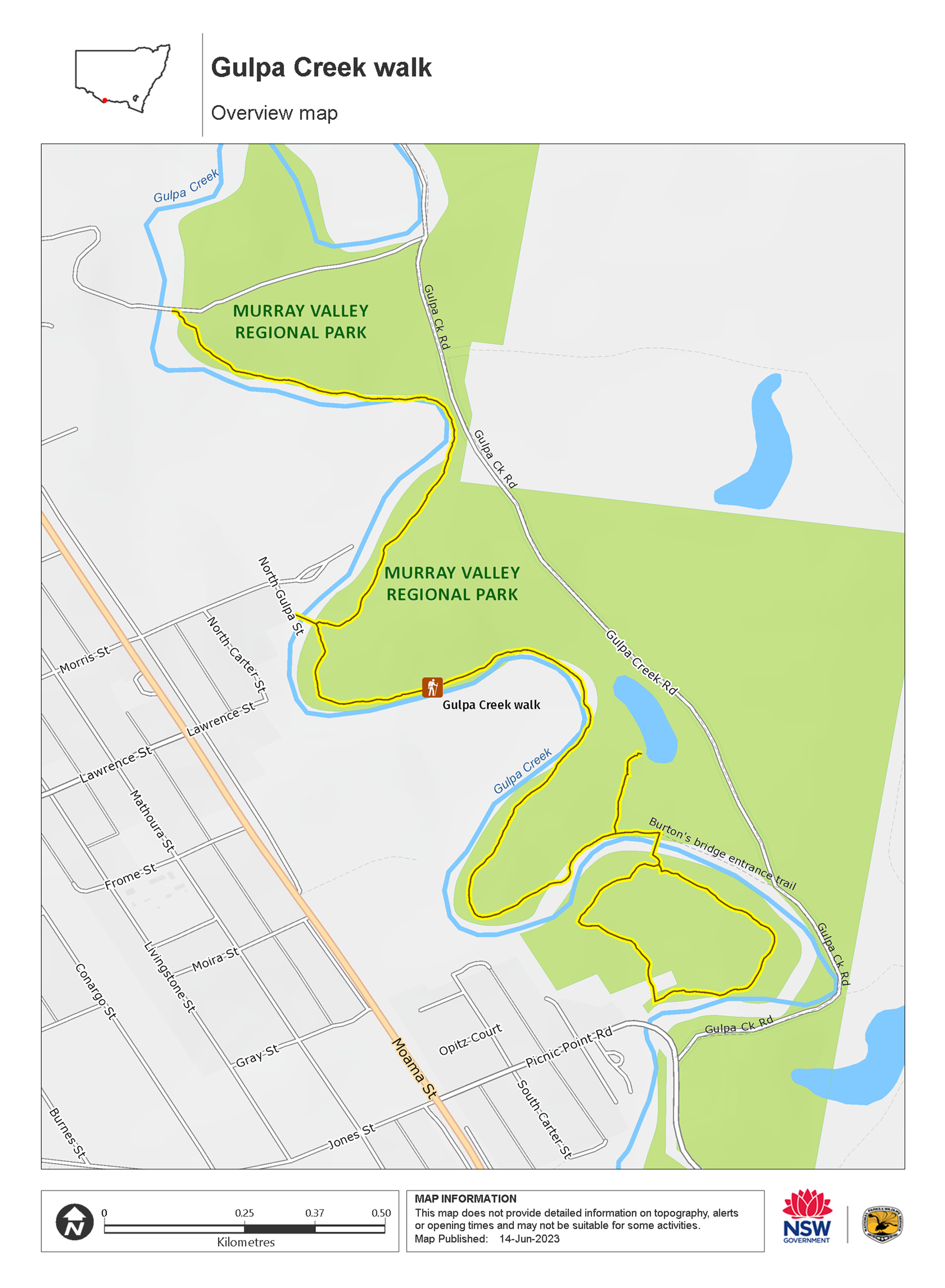
Map legend

Map
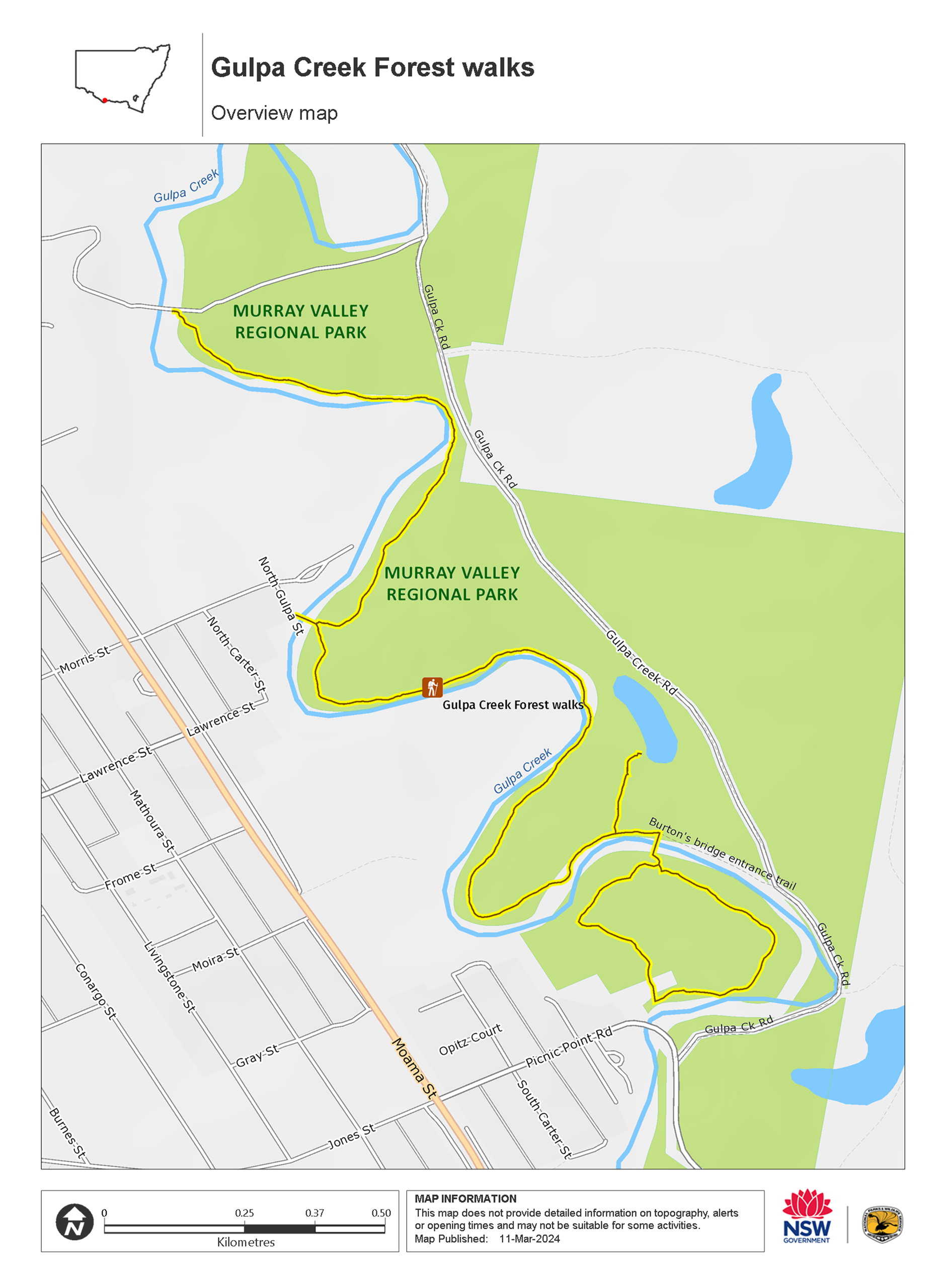
Local alerts
For the latest updates on fires, closures and other alerts in this area, see https://www.nationalparks.nsw.gov.au/things-to-do/walking-tracks/gulpa-creek-forest-walks/local-alerts
General enquiries
- National Parks Contact Centre
- 7am to 7pm daily
- 1300 072 757 (13000 PARKS) for the cost of a local call within Australia excluding mobiles
- parks.info@environment.nsw.gov.au
Park info
- in Murray Valley Regional Park in the Murray-Riverina region
Visitor info
All the practical information you need to know about Gulpa Creek Forest walks.
Maps and downloads
Learn more
Gulpa Creek Forest walks is in Murray Valley Regional Park. Here are just some of the reasons why this park is special:
Internationally significant wetlands

One of the most beautiful and ecologically important features of the river red gum forests is its wetlands. In 2003 the NSW Central Murray forests were listed under the Ramsar Convention of ‘Wetlands of International Importance’, placing these wetlands on the world stage.
- Kolety walking tracks Kolety walking tracks are a hidden oasis at Murray Valley Regional Park, in Deniliquin. Take an easy, dog-friendly stroll through river red gum forest to enjoy colourful birdlife or a riverside picnic.
- Riverside walk Riverside walk is an easy stroll through ancient river red gum forest in Murray Valley Regional Park, near Moama. Stretch your legs and look for yellow rosellas after a barbecue at Five Mile picnic area.
Rich Aboriginal culture

The Murray River region is one of Australia’s oldest living cultural landscapes and local Aboriginal people have a strong connection to the forests and rivers. The river red gum was used for its medicinal properties. A handful of young leaves, crushed and then boiled in water, was used as a liniment that was rubbed in for chest or joint pain, general aches and flu symptoms. Young leaves were also heated in a pit over hot coals and the vapours were inhaled, which helped with the treatment of general sickness.
- Riverside walk Riverside walk is an easy stroll through ancient river red gum forest in Murray Valley Regional Park, near Moama. Stretch your legs and look for yellow rosellas after a barbecue at Five Mile picnic area.
A bird lover's paradise

The Ramsar-listed Murray Valley wetland is home to over 60 threatened native animal species and 40 threatened plant species. Lay down the paddle of your canoe and sit in the silence, enjoying the company of egrets and cormorants, and keep an eye out for the superb parrot, slender and bright green. You may also see night herons, black swans, yellow rosellas, ducks, falcons, cockatoos, tree creepers, pardalotes, kingfishers and owls. This truly a bird-lover's paradise.
- Kolety walking tracks Kolety walking tracks are a hidden oasis at Murray Valley Regional Park, in Deniliquin. Take an easy, dog-friendly stroll through river red gum forest to enjoy colourful birdlife or a riverside picnic.
- Riverside walk Riverside walk is an easy stroll through ancient river red gum forest in Murray Valley Regional Park, near Moama. Stretch your legs and look for yellow rosellas after a barbecue at Five Mile picnic area.
Activities for everyone
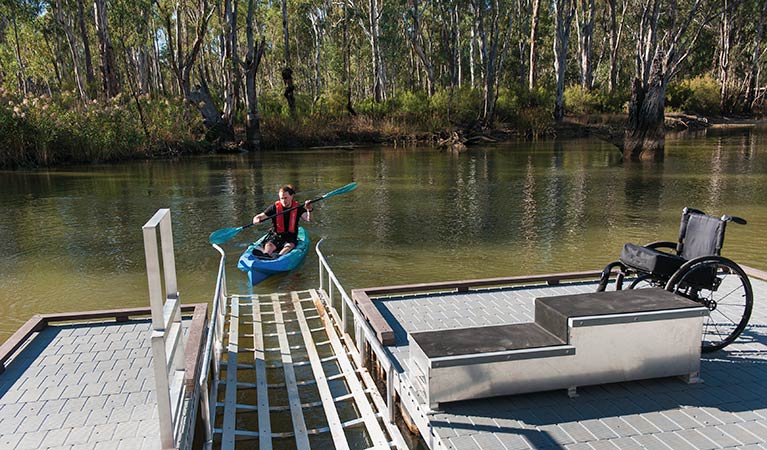
Because Murray Valley Regional Park is broken up into many areas there are experiences found only within a certain area of the park. The Moama (Five Mile) area is unique in that it contains the only formalised mountain bike track within the area. There are beautiful beaches where you can relax and camp over in Barooga and Mulwala and many places to throw in a line if you're keen for a fish.
- Deniliquin mountain bike trails Ride Deniliquin mountain bike trails in Murray Valley Regional Park. This popular singletrack cycling network is perfect for intermediate riders.
- Five Mile mountain bike trail Five Mile mountain bike trail offers 7km of purpose-built mountain bike trails in Murray Valley Regional Park, near Echuca and Moama. The trails are suitable for all skill levels and it's one of the best places for biking in the region.
- Kolety walking tracks Kolety walking tracks are a hidden oasis at Murray Valley Regional Park, in Deniliquin. Take an easy, dog-friendly stroll through river red gum forest to enjoy colourful birdlife or a riverside picnic.
European heritage

There's lots of hidden European heritage within Murray Valley Regional Park. Look for trees marked with large numbers along the Murray River. These trees were used as distance markers during a government survey in the late 1800’s. They were spaced 1-mile (1.6km) apart from Albury to Wentworth. During the paddle steamer era, people could use these markers to tell how far along the river they had travelled. You might also spot old cattle yards made from river red gum sleepers or peg trees which were used by timber cutters for climbing.
- Gulpa Creek Forest walks Gulpa Creek Forest walks, in Murray Valley Regional Park, is an easy path to walk along with your dog and great for birdwatching with opportunities to go canoeing or kayaking, not far from Mathoura.
Plants and animals protected in this park
Animals
-

Bare-nosed wombat (Vombatus ursinus)
A large, squat marsupial, the Australian bare-nosed wombat is a burrowing mammal found in coastal forests and mountain ranges across NSW and Victoria. The only other remaining species of wombat in NSW, the endangered southern hairy-nosed wombat, was considered extinct until relatively recently.
-

Common ringtail possum (Pseudocheirus peregrinus)
Commonly found in forests, woodlands and leafy gardens across eastern NSW, the Australian ringtail possum is a tree-dwelling marsupial. With a powerful tail perfectly adapted to grasp objects, it forages in trees for eucalypt leaves, flowers and fruit.
-

Common brushtail possum (Trichosurus vulpecula)
One of the most widespread of Australian tree-dwelling marsupials, the common brushtail possum is found across most of NSW in woodlands, rainforests and urban areas. With strong claws, a prehensile tail and opposable digits, these native Australian animals are well-adapted for life amongst the trees.
-

Australian pelican (Pelecanus conspicillatus)
The curious pelican is Australia’s largest flying bird and has the longest bill of any bird in the world. These Australian birds are found throughout Australian waterways and the pelican uses its throat pouch to trawl for fish. Pelicans breed all year round, congregating in large colonies on secluded beaches and islands.
-

Eastern blue-tongue lizard (Tiliqua scinciodes)
The eastern blue-tongue lizard, one of the largest skinks in Australia, is found throughout most of NSW. When threatened, the eastern blue-tongue lizard displays its blue tongue in a wide-mouthed intimidating show. Not an agile animal, they feed on slow-moving beetles and snails.
-

Emu (Dromaius novaehollandiae)
The largest of Australian birds, the emu stands up to 2m high and is the second largest bird in the world, after the ostrich. Emus live in pairs or family groups. The male emu incubates and rears the young, which will stay with the adult emus for up to 2 years.
-

Koala (Phascolarctos cinereus)
One of the most renowned Australian animals, the tree-dwelling marsupial koala can be found in gum tree forests and woodlands across eastern NSW, Victoria and Queensland, as well as in isolated regions in South Australia. With a vice-like grip, this perhaps most iconic but endangered Australian animal lives in tall eucalypts within a home range of several hectares.
-

Kookaburra (Dacelo novaeguineae)
Of the 2 species of kookaburra found in Australia, the laughing kookaburra is the best-known and the largest of the native kingfishers. With its distinctive riotous call, the laughing kookaburra is commonly heard in open woodlands and forests throughout NSW national parks, making these ideal spots for bird watching.
-

Lace monitor (Varanus varius)
One of Australia’s largest lizards, the carnivorous tree-dwelling lace monitor, or tree goanna, can grow to 2m in length and is found in forests and coastal tablelands across eastern Australia. These Australian animals are typically dark blue in colour with whitish spots or blotches.
-

Platypus (Ornithorhynchus anatinus)
One of the most fascinating and unusual Australian animals, the duck-billed platypus, along with the echidna, are the only known monotremes, or egg-laying mammals, in existence. The platypus is generally found in permanent river systems and lakes in southern and eastern NSW and east and west of the Great Dividing Range.
-

Short-beaked echidna (Tachyglossus aculeatus)
One of only 2 egg-laying mammals in the world, the short-beaked echidna is one of the most widespread of Australian native animals. Covered in spines, or quills, they’re equipped with a keen sense of smell and a tube-like snout which they use to break apart termite mounds in search of ants.
-

Southern boobook (Ninox novaeseelandiae)
The southern boobook, also known as the mopoke, is the smallest and most common native owl in Australia. With a musical 'boo-book' call that echoes through forests and woodlands, the southern boobook is a great one to look out for while bird watching.
-

Sugar glider (Petaurus breviceps)
The sugar glider is a tree-dwelling Australian native marsupial, found in tall eucalypt forests and woodlands along eastern NSW. The nocturnal sugar glider feeds on insects and birds, and satisfies its sweet tooth with nectar and pollens.
-

Superb fairy wren (Malurus cyaneus)
The striking blue and black plumage of the adult male superb fairy wren makes for colourful bird watching across south-eastern Australia. The sociable superb fairy wrens, or blue wrens, are Australian birds living in groups consisting of a dominant male, mouse-brown female ‘jenny wrens’ and several tawny-brown juveniles.
-

Swamp wallaby (Wallabia bicolor)
The swamp wallaby, also known as the black wallaby or black pademelon, lives in the dense understorey of rainforests, woodlands and dry sclerophyll forest along eastern Australia. This unique Australian macropod has a dark black-grey coat with a distinctive light-coloured cheek stripe.
-

Tawny frogmouth (Podargus strigoides)
Found throughout Australia, the tawny frogmouth is often mistaken for an owl due to its wide, powerful beak, large head and nocturnal hunting habits. The ‘oom oom oom’ call of this native bird can be heard echoing throughout a range of habitats including heath, woodlands and urban areas.
-

Wedge-tailed eagle (Aquila audax)
With a wingspan of up to 2.5m, the wedge-tailed eagle is Australia’s largest bird of prey. These Australian animals are found in woodlands across NSW, and have the ability to soar to heights of over 2km. If you’re bird watching, look out for the distinctive diamond-shaped tail of the eagle.
-

White-bellied sea eagle (Haliaeetus leucogaster)
White-bellied sea eagles can be easily identified by their white tail and dark grey wings. These raptors are often spotted cruising the coastal breezes throughout Australia, and make for some scenic bird watching. Powerful Australian birds of prey, they are known to mate for life, and return each year to the same nest to breed.
Plants
-

Billy buttons (Craspedia spp. )
Billy buttons are attractive Australian native plants that are widespread throughout eastern NSW in dry forest, grassland and alpine regions such as Kosciuszko National Park. The golden-yellow globe-shaped flowers are also known as woollyheads. Related to the daisy, billy buttons are an erect herb growing to a height of 50cm.
-

Black sheoak (Allocasuarina littoralis)
The black sheoak is one of a number of casuarina species found across the east coast of Australia and nearby tablelands. Growing to a height of 5-15m, these hardy Australian native plants can survive in poor or sandy soils. The barrel-shaped cone of the black sheoak grows to 10-30mm long.
-

Coachwood (Ceratopetalum apetalum)
Coachwood trees are Australian native plants that grow in warm temperate rainforests along coastal NSW. Also known as scented satinwood, the mottled grey bark of the coachwood has horizontal markings and a delicate fragrance.
-
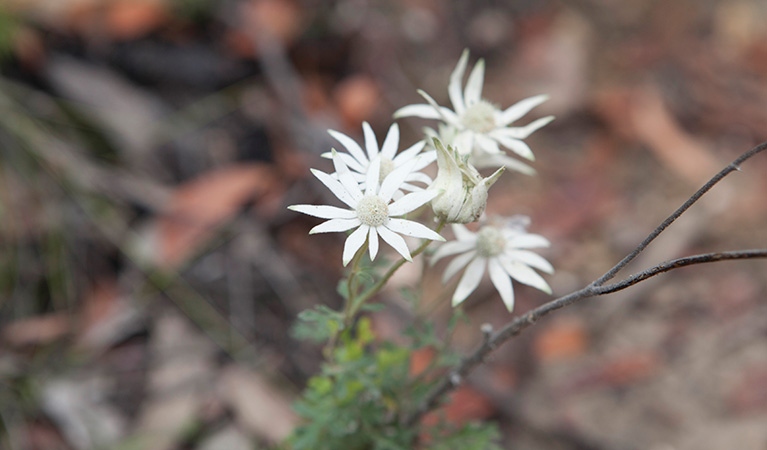
Flannel flower (Actinotus helianthi)
The delicate flannel flower is so named because of the soft woolly feel of the plant. Growing in the NSW south coast region, extending to Narrabri in the Central West and up to south-east Queensland, its white or pink flowers bloom all year long, with an extra burst of colour in the spring.
-

Mulga (Acacia aneura)
Mulga are hardy Australian native plants found throughout inland Australia. With an unusually long tap root, the mulga is able to withstand long periods of drought.
-

River red gum (Eucalpytus camaldulensis)
Australian native plants, majestic river red gum trees are widespread across Australian inland river systems. The river red gum is a dominant tree species of the Murray-Darling basin which spans NSW, Queensland and Victoria. This iconic native eucalypt grows to a height of 30m and is thought to have a lifespan up to 500-1000 years.
-

Saltbush (Atriplex nummularia)
A hardy Australian native plant, the saltbush is a small spreading shrub that can withstand dry salty soils such as those found in the desert plains of western NSW. It is grey-white in colour and has small spear-shaped succulent leaves. It flowers from December to April.

